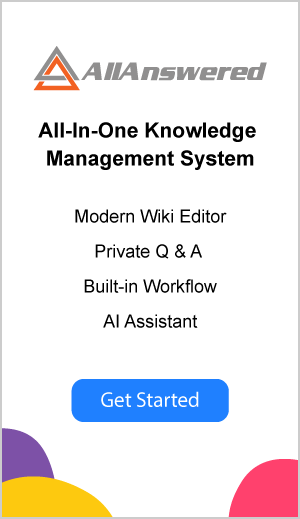5 Steps to a Successful Knowledge Management
How to Implement a Successful Knowledge Management System?
A successful knowledge management program requires a clear understanding of the objectives your company wishes to accomplish, how the organization will adopt changes, and how to measure success through a set of well-defined key performance indicators (KPIs). The key to achieving sustainable and long-term success requires a more systematic approach.
Implemented correctly, a knowledge management system:
- preserves employees' expertise and experience
- provides more clarity for better and faster decision making
- streamlines processes and eliminates redundant efforts
- improves cross-functional communications
- stimulates innovation through collaboration
In today's fast-paced world, to have a business positioned for success and long-term competitive advantage, it is critical to look past the physical assets and focus more on the value of knowledge of your company. Effective implementation of Knowledge Management (KM) can reap great rewards for the organization. It increases employee productivity, product quality, and service consistency by maximizing the power of their team's No. 1 asset - knowledge. In most cases, a decrease in expenses and costs will take place as well because more common mistakes and pitfalls can be avoided.
However, there are many obstacles and challenges to the implementation of a Knowledge Management System (KMS). Eager to reap the benefits, many organizations leap into a knowledge management program without careful planning and evaluation. They would soon run into issues with both organizational culture and technical implementation.
Get an in-depth understanding of the knowledge management system and why knowledge management system is needed.
3 Key Components of Knowledge Management
A successful knowledge management initiative should take all three core components of knowledge management into consideration. Only focusing on any one of them, your knowledge management journey is bound to fail.
- People
People are the core of your knowledge management program. A successful knowledge management program requires buy-ins from all your team members. They are motivated to participate because they get the information to do their job more effectively, and at the same time, they can influence others with their knowledge. Knowledge management also helps your organization establish and cultivate a knowledge-sharing, knowledge-driven culture that is critical for your long-term success. - Technologies
Technologies are the center of your knowledge management program. Your knowledge management system acts as a central repository for all your team knowledge and information. You can consider it the collective brain of your organization. The system should be designed to be easy and intuitive for anyone in the organization to use. It organizes knowledge in a more structured way that provides more clarity and facilitates better cross-functional collaboration. Modern technologies such as artificial intelligence (AI) can greatly enhance and automate the work required for knowledge management. - Processes
Establishing processes for knowledge management is the lifeblood of your knowledge management program. The processes you establish should include best practices, integrated workflow, and continuous improvement. Consistent processes adopted across the organization helps to identify critical knowledge, keep knowledge base up-to-date, and reduce the duplications and clutter.
Implementation Challenges
Implementing a knowledge management program is no easy task. It is both an organization issue and a technology issue. Even with a good understanding of the concepts and theories, you are still going to face many challenges, including:
- Missing the capability to capture tacit knowledge
- Perceived as "additional work" by some employees
- Lack of incentives and performance evaluation
- Software selected is hard to use and navigate
- System not integrated with employee daily workflow
- Lack of sponsorship from senior management
- No clear ownership
- Internal silos and conflicts
- Poor training or mentoring programs
5-Step Knowledge Management Implementation
The 5 steps listed below will guide you through the planning and setting up a successful knowledge management system. It will help you solve common challenges, minimize the risks, and maximize the long-term rewards and benefits.
It is based on our years of tried-and-true experience in helping our customers implement successful knowledge management programs. The systemic approach starts with program goal-setting, strategy planning, and requirements gathering. A successful implementation requires an alignment of the strategic objectives across the organization. Then the focus shifts to solution evaluation and execution. Due to the complexity of the program, don't expect everything to go smoothly the first time. That's why it is crucial to set up processes for continuous evaluation and improvement.
Step 1: Establish Objectives
As the very first step, take the time to define your objectives. Remember that different groups in your organization may have very different objectives. One very effective way is to set up brainstorming sessions with stakeholders. By visualizing what they hope to accomplish in terms of managing their group knowledge, common themes will start to emerge.
It is essential to write down the current problems that need resolution and the business drivers that justify the investment. Start with a gap analysis by comparing existing systems and processes with your ideal end goals. That gives you a good understanding of the scope of the program.
There are both short-term and long-term objectives that you should consider. Sometimes, it is a trade-off between satisfying short-term and longer-term goals, so all goals should be prioritized by the stakeholders. Plans based on such a prioritized list will seak quick returns of some critical issues and also lay a path for long-term benefits.
Step 2: Get Alignment
Knowledge management is more than just technology and tools — it’s a culture change. Many companies do not have a knowledge-sharing culture. Because employees are being evaluated based on their individual performance, people tend to hoard knowledge to themselves as a way to gain job security.
Implementing a new knowledge management program will require changes to existing practices and values. A culture change is difficult and it will meet resistance from some people. Generally speaking, changing culture is a top-down initiative. So it is imperative to have a champion from your senior management team who will be setting the mission and vision for the project.
The company incentive structure has to be adjusted to encourage knowledge-sharing behaviors within the organization. Buy-in from the majority of your employees requires transparency and two-way communication. When their inputs and concerns are heard and considered, they are more engaged and the new system adoption will be smoother.
Step 3: Define Processes
Clearly define the high-level knowledge management processes is a key step for effective implementation. High-level processes also guide you to progressively define the detailed requirements of the technology platform you will select. Inputs and feedback from all departments and stakeholders should be considered when documenting the requirements. Surveys and interviews are very effective in gathering such information.
Organizations that don’t clearly define their knowledge process are unlikely to achieve their knowledge management objectives set in step one. The processes should cover how knowledge is identified, captured, categorized, shared, and updated. It should be integrated with your existing workflow to minimize any friction.
The knowledge management software should be flexible enough to accommodate the processes you defined. It needs to support integrations with the tools that you currently using through plugins and extensions. Technology should enhance the processes not hider them.
Step 4: Implementations
Implementation starts with vendor evaluation based on the objectives and processes you defined in previous steps. The marketplace for the knowledge management system is vast and diverse. You should consider setting up a dedicated task force so you can thoroughly evaluate their solutions. Here are some key factors you should consider:
- Features. There should be no major holes in the feature set to achieve your objectives
- Usability. It has to be user friendly.
- Integrations. It should provide integrations with the tools you are already using to streamline the processes.
- Support. You will need strong support from your vendors during the actual implementation.
- Cost. It should provide a significant Return On Investment (ROI) for the organization.
Implementing a knowledge management program requires significant resources and commitment. Guided by the task force, your internal groups need to work closely with the vendor during the process. The task force also needs to develop good training materials for onboarding employees before mass deployment. Implementation progress should be reported to the senior management team to prevent any major surprises and risks.
Step 5: Measure and Improve
No matter how well you planned and executed on your knowledge management program, there is always room for improvement. But first, you need a way to measure the overall effectiveness of the program. Before you roll out the new system, you should establish some baseline numbers in order to capture key metrics prior to implementing the knowledge management program. For example, for a customer support team, you would collect data such as resolution time, resolution ratio, and customer satisfaction ratings. After implementation, periodically review and compare the new data to the old to see how much performance gain is achieved.
It may take some time for the organization to see significant improvements. Users need time to learn a new system. It takes even longer to change behavior, habits, and company culture. Don't be discouraged, and over time, the results will show.
After analyzing the data, you will gain valuable insight into what's working and what's not. You can then take the necessary actions to reinforce the positives and mitigate the negatives. Additional enhancement and new improvements are getting implemented. This continuous improvement approach enables an organization to create a positive feedback loop that makes the team more efficient and more competitive.
The Right Vendor is Your Partner
Implementing a knowledge management program takes time and resources. However, simply follow the 5-step process and you will be able to execute with confidence. Learning organizations that have made such investments in knowledge management have become more agile, more efficient, and more innovative.
When selecting the vendor for your solution, it is imperative to consider them as partners. Their solution must be robust, secure yet flexible. Their support team needs to work closely with your team to meet your expectations.
Here at AllAnswered, we helped companies big and small successfully deployed knowledge management systems since 2014. We would love to become your trusted partner and advisor for your knowledge management initiatives. Please contact us for a free demo and let us show you why we are the leading solution in the market.








